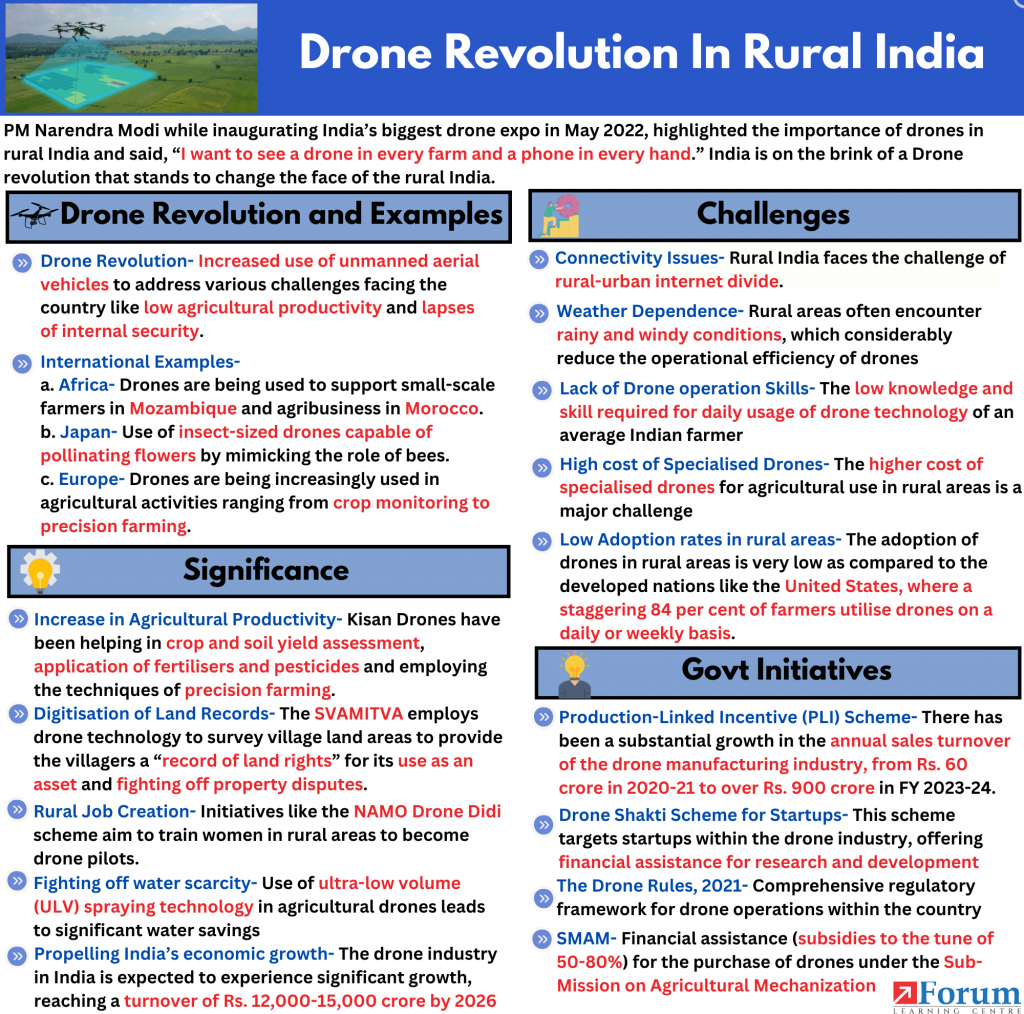ForumIAS announcing GS Foundation Program for UPSC CSE 2025-26 from 19 April. Click Here for more information.
ForumIAS Answer Writing Focus Group (AWFG) for Mains 2024 commencing from 24th June 2024. The Entrance Test for the program will be held on 28th April 2024 at 9 AM. To know more about the program visit: https://forumias.com/blog/awfg2024
India is on the brink of a Drone revolution that not only stands to change the face of the rural India but also has the potential to profoundly impact and improve countless lives in rural India. PM Narendra Modi while inaugurating India’s biggest drone expo in May 2022, highlighted the importance of drones and said, “I want to see a drone in every farm and a phone in every hand.”
What is Drone Revolution? What are the international examples of use in rural areas?
Drone Revolution- Drone Revolution refers to the increased use of unmanned aerial vehicles to address various challenges facing the country like low agricultural productivity and lapses of internal security.
International Examples of drone technology revolutionising agricultural practices and boost rural economies-
a. Africa- Drones are being used to support small-scale farmers in Mozambique and agribusiness in Morocco.
b. Japan- Use of insect-sized drones capable of pollinating flowers by mimicking the role of bees.
c. Europe- Drones are being increasingly used in agricultural activities ranging from crop monitoring to precision farming.
What are the advantages of Drone Revolution In Rural India?
1. Increase in Agricultural Productivity- Use of Kisan Drones– a rural drone revolution- has led to an increase in agricultural productivity by helping in crop and soil yield assessment, application of fertilisers and pesticides and employing the techniques of precision farming.
2. Digitisation of Land Records- The SVAMITVA scheme of the government aims to employ drone technology to survey village land areas to provide the villagers a “record of land rights” for its use as an asset and fighting off property disputes.
3. Rural Job Creation- Initiatives like the NAMO Drone Didi scheme aim to train women in rural areas to become drone pilots. This positions them at the core of economic activity and contributes to rural prosperity.
4. Fighting off water scarcity- Use of ultra-low volume (ULV) spraying technology in agricultural drones leads to significant water savings compared to traditional spraying methods.
5. Propelling India’s economic growth- As per projections from the Ministry of Civil Aviation, the drone industry in India is expected to experience significant growth, reaching a turnover of Rs. 12,000-15,000 crore by 2026. Also, the startups related to drones have been witnessing a tremendous growth which aid to India’s vision of becoming $5 trillion economy.
| Read More- SVAMITVA scheme |
What are the Challenges with the Drones in Rural India?
1. Connectivity Issues- Rural India faces the challenge of rural-urban internet divide. Limited online coverage poses a significant challenge to the drone revolution in India.
2. Weather Dependence- The weather dependence of drones for their enhanced operational efficiency also poses a significant challenge. As the rural areas often encounter rainy and windy conditions, the operational efficiency of drones is considerably reduced.
3. Lack of Drone operation Skills- The low knowledge and skill required for daily usage of drone technology is another prominent hurdle for an average Indian farmer.
4. High cost of Specialised Drones- The higher cost of specialised drones for agricultural use in rural areas is another major challenge for the increased use of Drones in rural India.
5. Low Adoption rates in rural areas- The adoption of drones in rural areas is very low as compared to the developed nations like the United States, where a staggering 84 per cent of farmers utilise drones on a daily or weekly basis.
What are the Government Schemes for ushering in the Drone Revolution in Rural India?
| Production-Linked Incentive (PLI) Scheme | The PLI scheme for drones and drone components offers incentives to manufacturers in this domain. There has been a substantial growth in the annual sales turnover of the drone manufacturing industry, from Rs. 60 crore in 2020-21 to over Rs. 900 crore in FY 2023-24. |
| Scheme for Women Self-Help Groups (SHGs) | This scheme focuses on providing drones to women self-help groups (SHGs) engaged in agriculture. There has been an allocated outlay of Rs. 1,261 crore for the period from 2024-25 to 2025-26. |
| Drone Shakti Scheme for Startups | This scheme targets startups within the drone industry, offering financial assistance for research and development, product development, and marketing. |
| The Drone Rules, 2021 | These rules establish a comprehensive regulatory framework for drone operations within the country. Digital Sky Platform serves as an online registration platform for drones and drone operators. |
| Drones in Agricultural Research | International Crops Research Institute (ICRISAT) was granted the permission by the Indian Government to utilise drones in agri-research. |
| Sub-Mission on Agricultural Mechanization (SMAM) | The Indian Government is also providing financial assistance (subsidies to the tune of 50-80%) for the purchase of drones under the Sub-Mission on Agricultural Mechanization (SMAM) |
What Should be the Way Forward?
1. Training and Skill Development- Focus must be on training the farmers for using the drone technology by themselves in their fields.
2. Internet Connectivity- The Internet connectivity in rural areas must be improved by the early implementation of Schemes like Bharat Net and 5G connectivity.
3. Lower the cost of Specialised Drones- An adequate policy must be formulated to lower the cost of specialised drones for agricultural usage. This will increase their adoption rates.
4. Design Weather Sturdy Drones- Weather sturdy drones for rural areas unaffected by strong winds and inclement weather conditions must be designed at the earliest.
Given the strong government focus, regulatory backing, liberal incentives, and appropriate training programmes, Drones have the potential to revolutionise Indian agriculture, playing a pivotal role in uplifting the rural economy.
| Read More- The Times of India UPSC Syllabus- GS 3- E-technology in aid of farmers |





